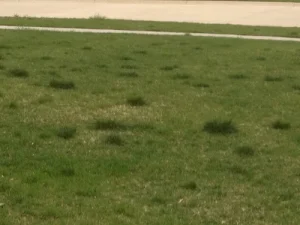It is a perennial nemesis of every home owner that rears its aggressive self every spring: Clumpy grass.
While pretty in the right natural setting, this nuisance grass is never going to end up on a Better Homes & Gardens cover and can dampen the overall look and health of your lawn. It stands out and stands tall like a square thumb. What makes clumpy grass so troublesome for homeowners is it’s not a grass that can be easily evicted from your lawn.
“When (Tall Fescue) dominates a mixed-grass lawn, it may appear as isolated, awkward-looking clumps rather than in a uniform mat like other grasses,” The Spruce’s David Beaulieu writes.
A common question we get every spring: How do I get rid of these clumps of grass?
What are the grass clumps in my yard?
 First, let’s define what these grass clumps are. Clumpy grass is called Tall Fescue, a rare and very durable grass with unfortunate staying power. First introduced to North America by European settlers who planted it to provide nutritious forage for livestock, Tall Fescue is drought resistant and doesn’t blend well with Kentucky bluegrass that is more common in Eastern Iowa. It can grow in full sun to part shade and adapts well to clay soil.
First, let’s define what these grass clumps are. Clumpy grass is called Tall Fescue, a rare and very durable grass with unfortunate staying power. First introduced to North America by European settlers who planted it to provide nutritious forage for livestock, Tall Fescue is drought resistant and doesn’t blend well with Kentucky bluegrass that is more common in Eastern Iowa. It can grow in full sun to part shade and adapts well to clay soil.
Tall Fescue is also shade tolerant and can thrive in areas where it’s too hot for cool grasses but too cold in the winter for warm-season grasses. Tall Fescue is adaptable to many types of soil and its deep roots can find nutrients and moisture in almost any soil type.
Most varieties of Tall Fescue, including Black Beauty and Dense Shade Mix, are still grown for use as pasture food for grazing animals. Its very nature makes it a poor match for lawns. And Tall Fescue grass and weeds don’t go away quietly without a fight.
“Tall Fescue in the lawn is a significant pests,” Gardening Now How’s Mary Dyer writes. “In fact, saying that controlling tall fescue is difficult is an understatement.”
What is the best way to control unwanted grass clumps?
Removal is really the best and only option to eliminate a Tall Fescue problem in your yard. For left unattended, Clumpy Grass can start becoming very evident in your lawn by the Fourth of July.
“The symptoms often appear in mid-summer, and the only solution is to remove affected patches and reseed,” Beaulieu notes.
Tall Fescue’s dense nature prevents it from being mowed below 1.5 inches.
“The thick root masses are nearly impossible to pull and mowing only encourages growth of this aggressive plant,” Dyer notes.
At Creekside Turf, we recommend digging out the clumps by hand or spot spray with Roundup, then reseeding affected areas.
How to curb clumping tall fescue before it grows into an eye sore?
For un-manicured lawns, Tall Fescue grass is heaven, requiring little work.
“Tall fescue maintenance is a dream for the lazy gardener because it needs infrequent mowing and haw low nutrient needs,” Gardening Now How’s Bonnie Grant writes.
But for lawns needing a clean uniform look to look their best, Tall Fescue isn’t an option. Tall Fescue weeds develop in early spring and reach maturity by late summer. Though pulling the weed is near impossible, you can dig up seedlings and isolated clumps early in the season.
If you are unable to curb the growth of fescue early, you may be able to spot treat weeds with products containing glyphosate. We advise spraying in spring or late fall. Herbicides are mostly non-effective when Tall Fescue weeds are dormant.
Be sure to religiously follow manufacturer recommendations and keep in mind that the herbicide may eradicate other plants as well. Wear chemical-resistant gloves and protective goggles, a long-sleeved shirt, long pants and closed toe shoes with socks.
For Tall Fescue is not a weed you want growing into a giant unsightly problem for your lawn.
For more information on pre-emergent fertilizer application for your lawn, contact Creekside Turf Management for a free consultation.
